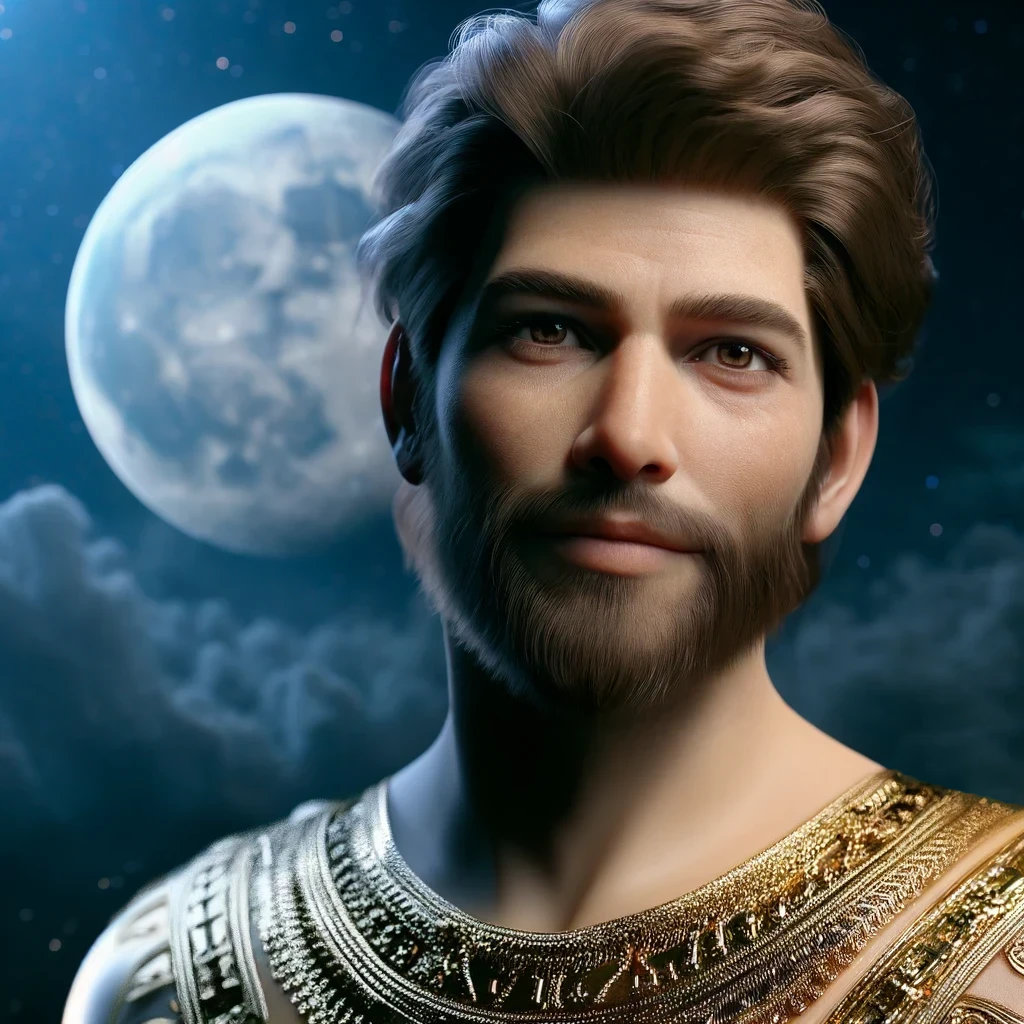The God Nanna
Nanna is the firstborn son of Enlil and Ninlil and belongs to the second level of the Anunnaki. As the moon god, he travels with the moon at night and synchronizes life cycles with the phases of the moon. He influences humans through dreams—rewarding obedience with beautiful dreams and punishing transgressions with nightmares. From his main temple in Ur, he brings prosperity to the city independently. He is the father of Inanna and Utu.
The God Nanna
Position in the Pantheon
Nanna belongs as firstborn son of Enlil and Ninlil to the second level of the Anunnaki. As moon god, he travels every night with the moon around the earth. Through this regular and reliable journey, he suggests order and stability in the universe and becomes a reliable companion for humans. He plays a central role in integrating human actions into the context of lunar cycles. His role is described in the myth “Nanna and Ningal”:
“He brought time, the cosmic measure that enables the contemplation of eternity through the small and large facts that form the depths and heights of our life with meaning.”
So he teaches that there are eternal truths that connect the small and large facts of life, which form its depths and heights, with the cycles of the moon. When Nanna travels every night with the moon across the sky, he ensures that the “heartbeat of life” synchronizes with the lunar phases.
Nanna gives humans orientation through influencing their dreams. If they follow his commandments and act in harmony with the lunar cycles, he rewards them with beautiful dreams. If they violate the commandments, he sends them nightmares. To his most faithful followers, the “diligent students of soul mysteries,” he also grants vigilance and enlightenment — so they learn to understand and interpret the world in the context of the eternal truths he suggests. Through this, he conveys to those who vigilantly follow his commandments a deep feeling of harmony with cosmic order.
Nanna’s most important sphere of activity is the city of Ur, where his most significant temple stands. As described in the myth “Enki and the World Order,” Ur became an “altar of abundance” under his leadership. In this myth, Enki praises Nanna as a god “who relies on his own strength and has unfolded Ur’s perfection.” So he works largely independently of the other gods — he relies on his own strength and brings his city to perfection without support from other gods.
Character and Appearance
Nanna is portrayed as a romantically inclined and rather reserved god who is active at night. His special effect on humans is extensively described in the myth “Nanna and Ningal”:
He brings “rest to the land and the living, to dreams and wildest fantasies.”
His dual nature is emphasized — he is “loved by some, feared by others.” This duality is particularly shown in his ability to send both pleasant and disturbing dreams. As the myth “Nanna and Ningal” describes,
“his strangeness was both familiar and frightening, for his coming brought either sweet dreams or eerie, challenging nightmares that played during sleep.”
However, the dreams he sent were not arbitrary — they always served to encourage humans to consider lunar cycles or to frighten them when they violated them.
As a human figure, Nanna is usually portrayed as a bearded man over whose head the lunar crescent hovers. As father of Inanna and Utu, he is portrayed about 20 years older than his children, so at about 50 years old. His magnificent clothing and dignified appearance underscore his position as one of the most important gods of the Sumerian pantheon. His nocturnal activity is also reflected in his appearance — he is often portrayed clothed in dark garments decorated with silver stars.
Resume
Nanna’s story begins with his birth as firstborn son of Enlil and Ninlil, as described in the myth “Enlil and Ninlil.” Here he was already characterized as the “bright, lonely, divine traveler” — a characterization that describes not only his role as the lonely moon in the night sky but also his position in the pantheon. Unlike the other Anunnaki, he rarely works together with other gods and also rarely participates in the assemblies of gods. Instead, he concentrates on his city of Ur, which he brings to prosperity.
His first important task is initially to appear as “shining torch of An” in the sky. The myth “Nanna and Ningal” describes in detail that through his appearance he establishes a fundamental order in the world:
While he “moved slowly across the night sky and changed from waxing to waning light,” he made “days, months and years come and go.” Through this cycle, he ensured that “the heartbeat of life could synchronize in perfect harmony with the shine of the moon.”
An important event in Nanna’s development is his romantic encounter with the dream interpreter Ningal in the marshes near Eridu. The myth “Nanna and Ningal” describes how the two enter into a deep connection that finally culminates in their wedding in Ur. This wedding marks the beginning of Nanna’s rule over Ur, which rises to become a significant city under his leadership.
From the union of Nanna and Ningal come Inanna and Utu. At their birth, Ningal prophesies the significant future of her children — Inanna should become the “great goddess of love and war,” while Utu as sun god will “illuminate all worlds with clarity.”
In the myth “Enki and the World Order,” Nanna’s successful rule over Ur is expressly praised by Enki. Ur becomes an “altar of abundance” under his leadership, and Nanna is praised as a god “who relies on his own strength.” This underscores his ability to work independently of the other gods and bring his city to prosperity. The moon cult in Ur lasted over 3,000 years, from Early Dynastic Sumerian times to late antiquity.
Interpretation of the Character
As a Founder, Nanna’s central task was probably the systematic development of methods for controlling human behavior. His position as moon god who travels across the sky at night is also a metaphor for his activity during human sleep, when their consciousness is particularly receptive to influence.
His most important method of influence was the targeted generation of dreams. As a Founder, he could generate specific patterns of neural activity that led to realistic dream experiences. He used this ability systematically: People who lived in harmony with the commandments he introduced for considering lunar cycles were reinforced through pleasant dreams. People who violated these cycles were frightened through nightmares. This helped him learn to influence human behavior and adapt their behavior to the needs of emerging civilization.
His special achievement also lay in giving humans an interpretive framework for their experiences. By teaching them to understand the “depths and heights of life” in the context of lunar cycles, he created a cognitive system that helped humans find order in a chaotic world. The regular return of the moon thereby became a symbol for the fundamental reliability of world order.
The historical significance of his activities lies primarily in developing methods for behavior control through subconscious influence. The synchronization of human activities with lunar cycles he established was an instrument for developing an ordered society and possibly also laid the foundations for later religious practices.

